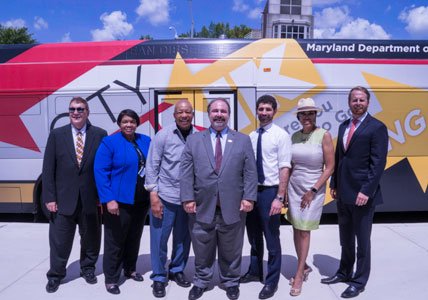BALTIMORE — Last school year, Brittany Patterson’s commute to work started at 5:45 a.m. on the 91 bus from Garrison Boulevard and Bateman Avenue. A few stops away at North and Bloomingdale, a block from Hilton Street, the crown of the corridor, she would get off and wait inside the bus shelter in front of the Walbrook Branch of the Pratt Library for the 13 bus with her two-year-old daughter asleep in her arms.
The 13 took her to Penn-North Metro Subway station, where she caught the train downtown to catch another bus over to the East side to her daughter’s daycare. From there, she went to her job as a classroom aide at Harford Heights Elementary School, situated near the rear end of the North Avenue corridor at Broadway.
The Penn-North station plays a vital role in Patterson’s everyday travels. Without it, getting to work would take a lifetime.The same is true for the nearly four million passengers who use the North Avenue corridor to connect to places of work, home and play throughout the city.
To that end, North Avenue, the Maryland Transit Administration’s (MTA) second busiest bus line, is getting a makeover as part of Governor Larry Hogan’s transformative BaltimoreLink Transit improvement plan.
Earlier this month, the MTA was granted $10 million of federal funds to complete the North Avenue Rising Project, which aims to revitalize the community and improve transit in Baltimore. The funds come from the U.S. State Department of Transportation’s Transportation Investment Generating Economic Recovery (TIGER) Grant. The grant compliments $14.7 million committed by MDOT, $1.6 million from U.S. DOT’s Federal Highway Administration and $1 million from Baltimore City.
“I want to make sure that we who have cars don’t forget about the people who have to take buses,” said Congressman Elijah Cummings at an August 12 press conference. “Transportation allows people to be able to live; it brings life to life.”
North Avenue was already included in the MTA’s $135 million revision of the citywide transit network. Most of the evidence of this plan at work is in midtown, between Howard Street and Greenmount Avenue. Street trees have sprouted from manicured median strips, bus shelters have been redesigned and beautified, and bike facilities are no longer few and far between and bike lanes have been placed on streets crossing the corridor in Charles Village like Guilford Avenue’s Bike Boulevard. Additional federal funds have secured improvements to the rest of the corridor that include dedicated bus lanes, transit signal priority at intersections, streetscaping, roadway re-paving, and enhancements to the Light Rail and Metro Subway stations.
Replacing transit infrastructures on North Avenue is about more than impacting the flow of traffic by adding of bike and bus lanes. It’s also about improving the quality of life for residents and reconnecting the city.
The transit-sector is a vital component of today’s global economy. Economic and development opportunities have become increasingly related to the mobility of information, goods and people. Efficient transport systems provide social opportunity and benefits that include increased accessibility to markets, schools, and employment that have a multiplied effect on the entire community.
According to the demographics presented in the North Avenue Rising Project’s TIGER grant proposal, unemployment in communities along the North Avenue corridor is 16.5 percent compared to the city’s seven percent; vacant houses account for 35.1 percent of dwelling space compared to the city’s 17.5 percent; and 24.7 percent of the population does not hold a high school diploma or GED compared to the city’s 19.9 percent.
“State-of-the-art infrastructure that supports multimodal transportation for city residents makes economic opportunities accessible,” said Mayor Stephanie Rawlings Blake. “Building effective transit infrastructure has positive impact on the quality of life of our residents including access to jobs and opportunities. When a resident has the opportunity to grow financially it is a positive outcome for the entire community.”
The North Avenue Rising Project is one of 41 winning projects around the country to be awarded the TIGER grant out of over 600 applicants. Congressman Cummings acknowledged this as a major feat for Baltimore and the state of Maryland. But more importantly, he commended the Obama administration’s commitment to a nationwide transportation plan to rebuild and expand transit lines around the country.
“I don’t want us to lose sight of the fact that this is a part of the Obama legacy,” said Cummings. “So many people don’t want to give him credit for anything. But as he leaves office I want to make it clear that these TIGER grants started because of him and they continue because of him and now all of us have to come together as he moves out of the White House to make sure these efforts continue.”
Cummings also made clear that in the face of national spotlight on the city’s challenges, his faith in the potential of Baltimore remains unmoved.
“I have often said that Baltimore will be fine. There are so many great things that are happening in our city. We are in one of the top five states for millennials moving in. Businesses are moving in fast. [We have] great leadership,” he said. “The question is never whether, to me, Baltimore will do well. The question is whether all of Baltimore will rise together.”
